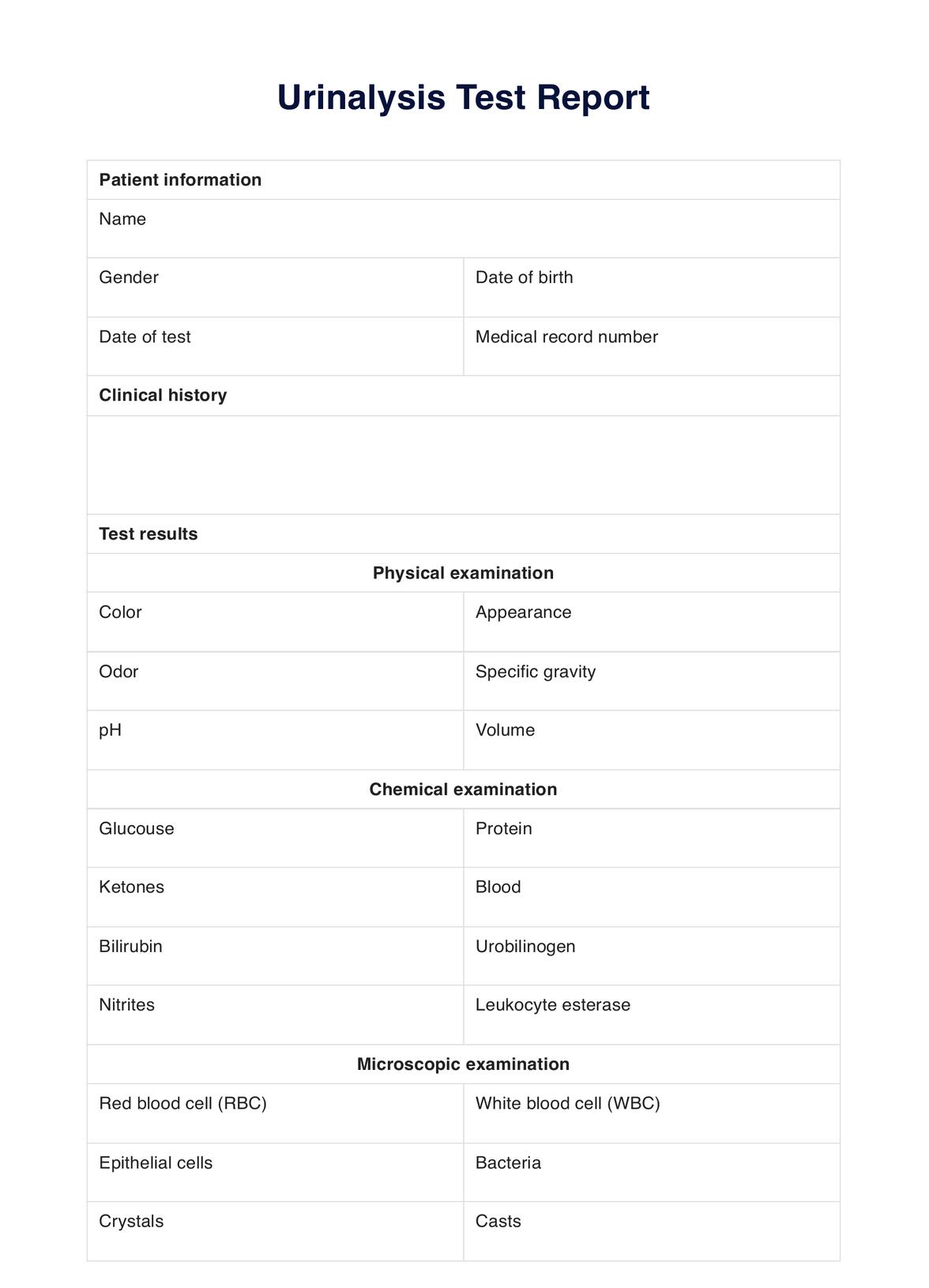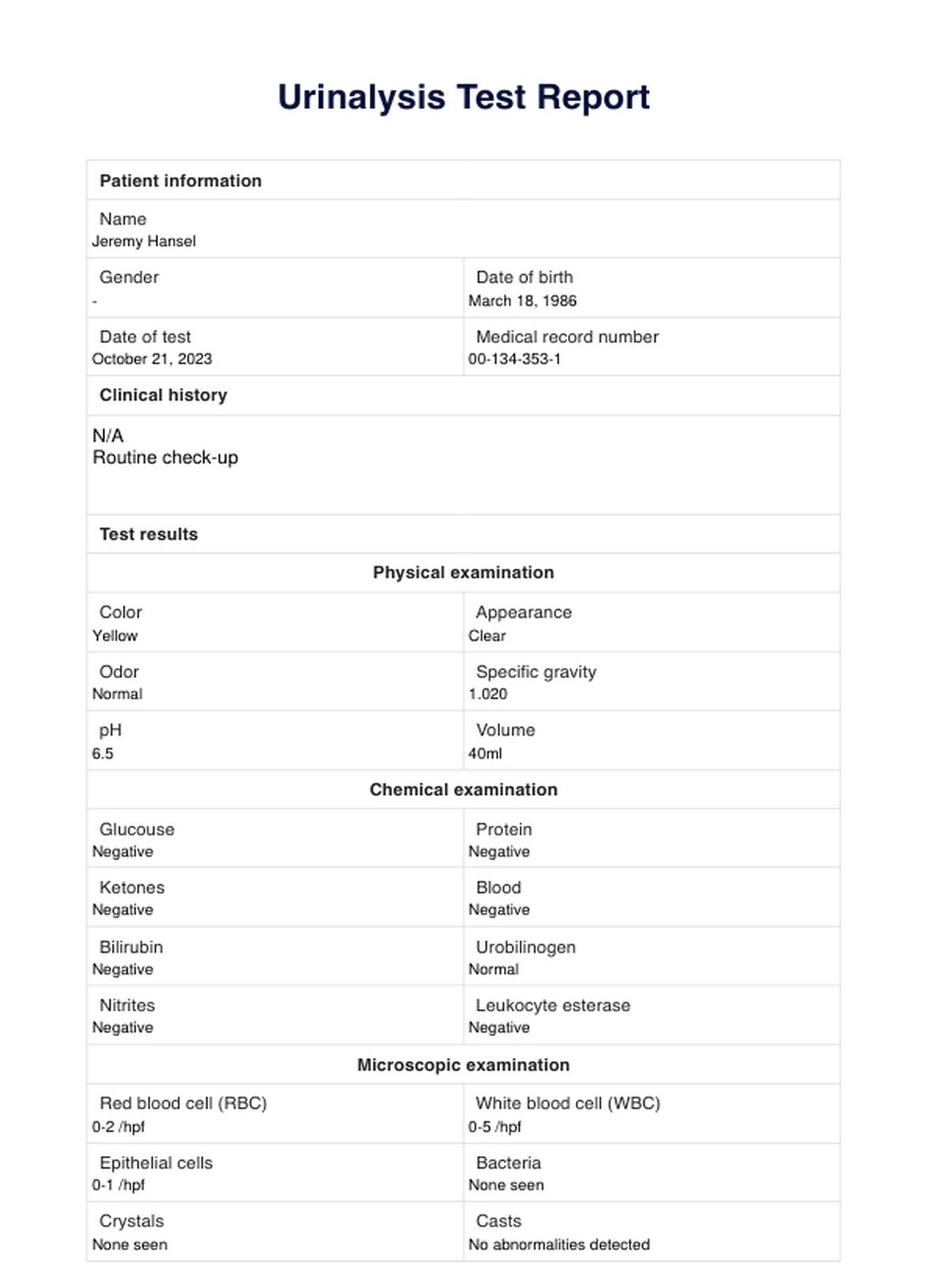Urinalysis
Optimize your Urinalysis workflow with our Urinalysis test report template PDF.


What is a Urinalysis test?
A Urinalysis test is a common and essential diagnostic tool that allows you to gain valuable insights into your patient’s overall health. By analyzing a urine sample, this test helps you assess various components, such as red and white blood cells, glucose, protein, and bilirubin levels. It also evaluates urine pH levels, indicating whether the urine is acidic urine or alkaline urine, which can be crucial for diagnosing various health conditions. These measurements can reveal critical information about your patient’s metabolic, renal, and liver health, aiding in diagnosing conditions like urinary tract infections, kidney disease, and diabetes.
The procedure for complete Urinalysis is straightforward: your patient provides a urine sample in a sterile container, which is then analyzed in a lab using urine dipstick tests, urine microscopy, and chemical analysis. The results, typically reported and documented in a complete Urinalysis report form, can be used to monitor your patient’s health over time, assess the effectiveness of treatments, and guide further medical investigations when needed.
Urinalysis Template
Urinalysis Example
How to use our Urinalysis test report template?
Using our Urinalysis test report template is a simple and efficient way to organize and document your patient's test results, especially after performing a dipstick test. This tool is designed to streamline your workflow, ensuring that all relevant information is captured accurately. Here’s how to make the most of it:
Step 1: Access the template
Start by downloading the free Urinalysis test report template from the Carepatron platform. It’s easily accessible through the link on this page, the Carepatron app, or our resources library.
Step 2: Enter patient details and test results
Begin by entering the patient’s essential details, such as their name and date of birth. Then, the Urinalysis results will be documented, including values from the dipstick test for components like glucose, protein, and white blood cells, along with their reference ranges.
Step 3: Save, interpret, and share
Once the report is complete, save it to your patient’s electronic health record for future reference. Use the template’s interpretation section to summarize findings and share the report with other healthcare professionals involved in the patient’s care for seamless communication.
When would you use a Urinalysis test?
A Urinalysis test is a versatile tool in various clinical scenarios. You might order this test when you suspect a urinary tract infection (UTI) in a patient who presents with symptoms like pain during urination, frequent urges to urinate, or cloudy urine. Additionally, analyzing urinary sediment in a Urinalysis test, which includes white blood cells (WBCs), red blood cells (RBCs), and epithelial cells, can provide diagnostic significance.
You’ll also find Urinalysis particularly valuable when monitoring patients with chronic conditions like diabetes or kidney disease. For instance, checking glucose levels in urine can help you assess how well a diabetic patient is managing their blood sugar. Similarly, protein in the urine might alert you to early signs of kidney dysfunction, allowing for timely intervention. Calcium oxalate crystals, characterized by their 'envelope shape,' can be clinically significant in acute kidney injury and may indicate ethylene glycol ingestion.
Urinalysis can also be part of a standard health check-up in more routine settings. It provides a snapshot of your patient’s metabolic and renal health, helping identify issues like dehydration, liver and renal disease, or even systemic conditions before they become more serious. It also plays a role in diagnosing renal tubular acidosis (RTA), which is important for evaluating urinary pH levels and differentiating various RTA types based on the body's acid-base balance.
What do the results mean?
Interpreting Urinalysis results is essential for gaining insights into your patient’s overall health and identifying potential underlying conditions. The various components measured in a Urinalysis can point to specific health issues, making it a valuable diagnostic tool. Here’s a breakdown of key findings and what they could mean:
- Proteinuria (high protein levels): This could indicate kidney disease or infection, as healthy kidneys typically prevent protein from leaking into the urine.
- Pyuria (white blood cells in urine): Typically signals inflammation or infection in the urinary tract, requiring further investigation.
- Glucosuria (glucose in urine): Often suggests high blood sugar levels, pointing to diabetes or prediabetes.
- Ketones in urine: Indicates that the body is using fat for energy instead of glucose, which may signal poorly managed diabetes.
- Elevated bilirubin/urobilinogen: This may suggest liver or gallbladder dysfunction, necessitating further liver function tests.
- Nitrites: Usually associated with urinary tract infections, indicating the presence of bacteria in the urinary system.
- Urine pH levels: Can provide insights into the risk of kidney stone formation, particularly uric acid calculi.
- Uric acid crystals: Important for diagnosing conditions like acute kidney injury and gout; identified by their distinct diamond or barrel shapes.
- Dilute urine: Can indicate conditions like diabetes insipidus, where the body’s ability to concentrate urine is impaired.
By assessing these components, you can comprehensively understand your patient’s health. However, remember that Urinalysis is just one piece of the puzzle — using it with other diagnostic tools is essential for forming a complete and accurate diagnosis, guiding further testing, and tailoring treatment plans.
Main takeaway
Urinalysis is a versatile diagnostic tool that provides critical insights into various health conditions, from kidney disease and diabetes to liver dysfunction and urinary tract infections. Healthcare providers can make informed decisions that enhance patient care by carefully interpreting the results and considering the broader clinical context. However, it's important to remember that Urinalysis should be used with other diagnostic tests to ensure a comprehensive understanding of your patient’s health, leading to more accurate diagnoses and effective treatment plans.
Commonly asked questions
The frequency of Urinalysis testing depends on the patient’s health status and risk factors. For those with chronic conditions like diabetes or kidney disease, regular Urinalysis tests may be part of routine monitoring. For others, it may only be necessary during annual check-ups or when symptoms suggest a potential issue.
Urinalysis effectively detects urinary tract infections and can reveal signs of kidney infections, but it may not detect all types of infections in the body. Analyzing a urine specimen provides comprehensive diagnostic insights, including cellular elements in urinary sediment and abnormalities indicating infections or other medical conditions. If an infection is suspected outside the urinary system, additional tests may be required to diagnose the condition accurately.
If a Urinalysis reveals abnormal results, such as with urinary nitrates and increased squamous epithelial cells, following up with further testing or diagnostic procedures is important to identify the underlying cause. Depending on the findings, this could involve blood tests, imaging studies, or specialist referrals to ensure an accurate diagnosis and appropriate treatment.













































































































